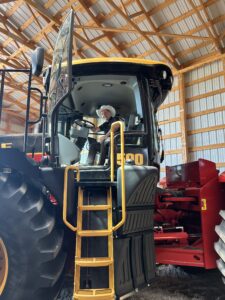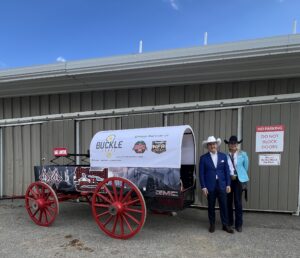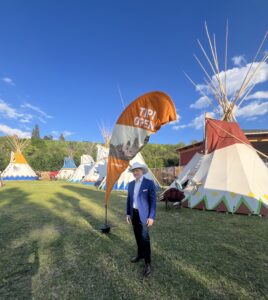Canada’s Wild Rose Country: Alberta’s Contributions to our Nation
Senator Loffreda writes about his recent trip to Alberta with a group of Senators.
Alberta is home to nearly 5 million Canadians. With a booming high-tech sector and a reputable global agri-food industry, it’s the heart of Canada’s oil industry. It’s also the place that gave Canadians hope this year that Lord Stanley would return to Canada after a 31-year drought.
I was tremendously proud of seeing our country rally behind the Western Conference Champions, Edmonton Oilers this spring as we all stood behind McDavid and his crew, who provided us with nail-biting moments and heart-pounding excitement.
Like with the Oilers last month, it would be great to see Canadians rally behind Alberta and get a better appreciation of its many contributions to our country’s prosperity and growth. That’s exactly what I had a chance to do when I recently spent four days in Alberta as part of a “familiarization tour” organized by my Alberta colleague Scott Tannas.
I had been to Alberta before but having an opportunity to meet the very friendly people of Alberta and learn more about what drives its economy was a rewarding experience. In some ways, I think Alberta is sometimes misrepresented or misunderstood by the rest of Canada – which is something Quebecers know something about.
Oil production is obviously synonymous with Alberta, but there is so much more to Alberta. Regardless of where you stand on the matter, Canada is a global energy powerhouse. We have the fourth-largest global supply of proven oil reserves. The oil and gas sector contributes $235 billion to our nominal GDP with over 412,000 direct and indirect jobs. The oilsands alone, for example, contributed over $20 billion in taxes and royalties to all levels of government in 2023. During our visit to Fort McMurray, we met with oil executives and visited Suncor’s Base Plant Operations where 350,000 barrels are produced and shipped each day.
According to the federal government, Alberta is also home to more than 16% of Canada’s cleantech companies and more than half of them relate to the energy industry, operating in renewables, energy efficiency, and smart grid technology.
Under the stewardship of the Pathways Alliance, Suncor has come together with the other five largest oilsands producers to find innovate ways of reducing their emissions. In fact, thanks to cleantech, the industry has reduced its emissions intensity by 23% between 2009 and 2022, and the Alliance is currently exploring the possibility of building major carbon capture units to make further reductions. I know Canada can be at the forefront of the clean energy transition and our visit to Fort McMurray confirmed that.
Of course, innovation is not unique to the oil industry. The agri-food sector, another one of Alberta’s major economic drivers, is at the forefront of new technologies. Beyond the obvious benefit of providing Canadians (and the world) with high-quality, healthy food, the industry contributes significantly to our nation’s GDP ($10.3 billion in 2022) and employs approximately 69,000 Albertans. The sector has an aggressive investment attraction strategy which has already successfully attracted $2.1 billion in investments in the last five years. These investments will contribute to the development and application of new technologies to increase the quantity and quality of agri-food products in Alberta and beyond.
These technological improvements are bound to contribute to the industry’s overall expansion which has already set a third consecutive record high for total agricultural exports in 2022 at $16.2 billion. While in Alberta, we visited the MacMillan Hutterite Colony and the Lowe Ranch, just outside High River.
In the past six months, Alberta has also been responsible for 90% of all of Canada’s private sector employment growth. That’s good news for Alberta as private sector job creation is a cornerstone of a strong economy. According to the Business Council of Alberta, these new jobs have largely been driven by gains in the construction industry, finance, forestry, mining and oil and gas. Beyond those sectors, nearly 10% of all jobs in Alberta are attributable to tourism-related business activities.
Like in any other province, tourism plays an important role in regional and local economies. Alberta is no different and this was clearly in evidence when our group visited Banff and Lake Louise. The industry has yet to return to pre-pandemic activity, but the future is bright. In 2022, total visitor expenditures were $600 million higher than in 2019, reaching $10.7 billion. While in Banff, we were spoiled to have the city’s former mayor, and now Senator, Karen Sorensen speak to us about the region’s many attractions and global appeal.
One thing is for sure: for four days, Senators were reminded why Alberta is an important part of our federation. As Senators, we are uniquely positioned to take the long view when it comes to public policymaking and I felt, as did my colleagues, that visiting Alberta gave us an opportunity to better understand the province’s reality including its current concerns, and more importantly, its opportunities for the future. I learned so much during our visit and I thank Senator Tannas for organizing this extraordinary tour of the province. It was a wonderful way to kickstart the summer.
The Honourable Tony Loffreda, Independent Canadian Senator (Québec)
Here below, some photos of Senator Loffreda’s trip to Alberta











